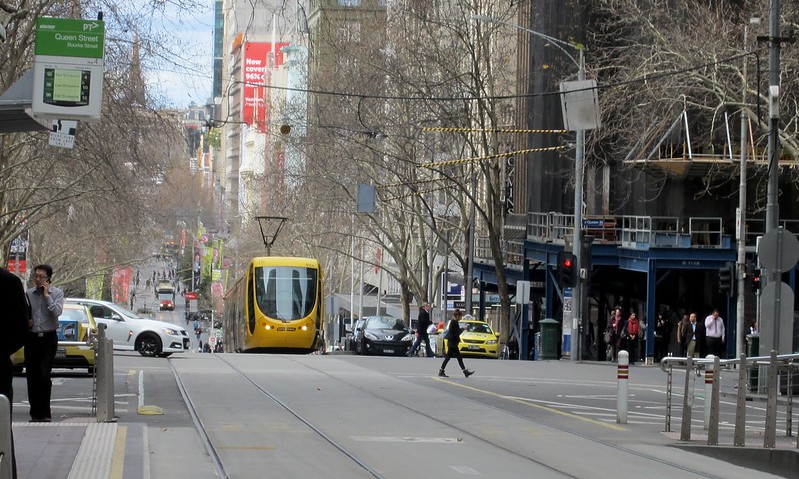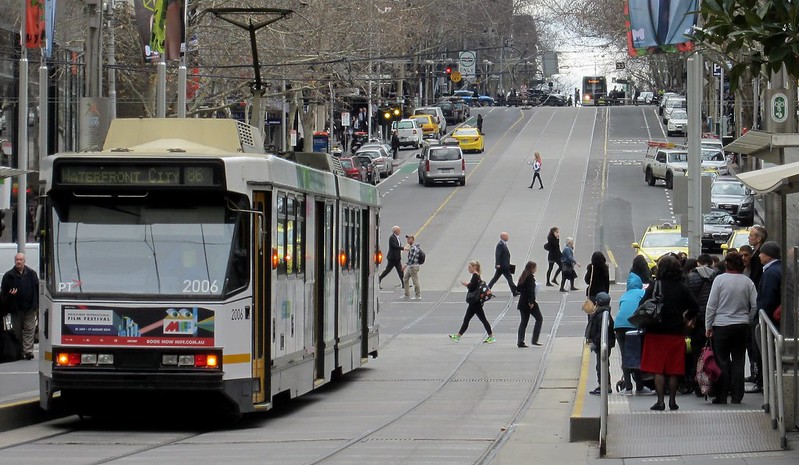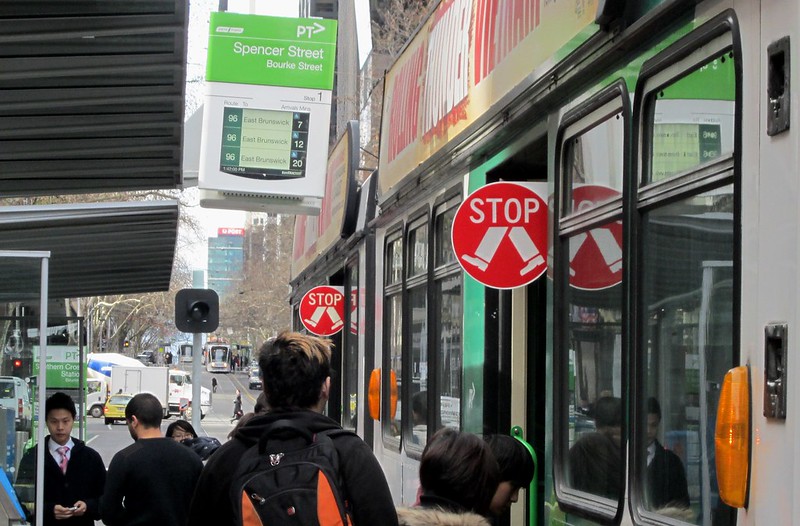It’s not uncommon to see trams stopped at traffic lights along Bourke Street, sometimes in queues, at locations where there is no stop.
If you’ve wondered why your tram journey is start-stop, it won’t surprise you to learn that the lights are all over the place.
With the handy-dandy stopwatch function on my mobile phone, I timed the lights along the central and western section of Bourke Street.
Bourke 30 / Swanston 30 = 60 second cycle
Bourke 35 / Elizabeth 35 = 70
Bourke 47 / Pedestrian crossing near Hardware Lane 23 = 70
Bourke 40 / Queen 50 = 90
Bourke 30 / William 60 = 90
Bourke 30 / King 70 = 100
No wonder trams have to stop continually at lights!
Along Bourke Street, and other CBD tram streets, there are numerous improvements that could be made…
Shorter cycles — There are obviously competing demands on the various streets. Because of large numbers of pedestrians, you can’t necessarily have pre-emptive traffic lights that detect trams coming and switch instantly to give them the green. But you could certainly reduce the cycle times. Judging from existing timings, even with our wide streets, it could be as little as 30 seconds each way, or a cycle every 60 seconds. This would greatly cut down waiting times for trams and walkers and everybody else for that matter — but you’d need to check the 15ish seconds Green Man time is enough to get waiting pedestrians off the kerb.
The King Street intersection is particularly bad, giving most of its time to cars — despite Vicroads data showing traffic on all segments of King Street between Flinders and Latrobe Street dropping between 2001 and 2011, and despite that policy should not be to prioritise cars in and through the CBD.
But William Street is almost as bad, despite having much fewer trams than Bourke Street (typically 5 per hour on route 55 vs about 15 per hour on routes 86 and 96 combined).
To help tram drivers know when to depart, for the spots where traffic lights are distant from the tram stops, they should get these lights working — they’re meant to indicate when the best time is to take off. It doesn’t necessarily result in a quicker trip for the tram, but it may allow the driver to wait for passengers who might otherwise miss the tram, while knowing the tram isn’t about to miss a green light.
That’s the theory, but they never seem to actually operate.
Co-ordinated cycles — For where there are multiple intersections which are between tram stops, whether or not they are short cycles or long, they should at least be co-ordinated. In this section the important ones are the intersections at Elizabeth and Queen Streets, as well as the pedestrian light in the middle. A tram leaving the Elizabeth Street stop westbound, and not delayed by anything else, should never get a red light before the next stop — and vice versa.
Obviously you’d need to work out the best cycles for the intersecting streets as well — for trams on Elizabeth Street and buses on Queen Street. But how hard could it be?
With the recent movement of tram stops, there are now similar blocks of traffic lights between stops along Swanston Street and Elizabeth Street.
Traffic light programming isn’t the only cause of tram delays of course.
But if moving people quickly and efficiently around the CBD is a priority — and it should be — these issues need to be addressed.
- A PTUA study found up to 30% of tram travel time is spent wasted waiting at red lights



14 replies on “Traffic light programming is why your CBD tram trip is start, stop, start”
Presumably it’s VicRoads who get their way with respect to traffic light timings and not Yarra Trams. And it’s pretty obvious that these organisations don’t talk to each other.
So thanks for getting the issue some coverage – as you say, it can’t be that hard!
The conflicting movement of tram routes at Spencer and Spring is another issue (eg 86 right from Bourke into Spencer, 96 left from Bourke into Spencer). Probably requires some thinking about a broader reallocation of routes across the network in the Hoddle Grid (additional tracks for right hand turning trams like at St Kilda Road onto Southbank Blvd from Route 1 probably aren’t an option in the Grid)
@Roger, I’d have to check, but I believe it’s City of Melbourne that controls these streets/intersections. In any case, the Vicroads SmartRoads strategy says the entire Hoddle grid is priority for trams, buses and pedestrians, not traffic – which at the very least should mean King Street’s cycles don’t dominate over its cross streets.
@Gobillino, yeah there are issues with trams turning, and this is why I get uneasy about proposals to increase the number of tram turns in the CBD – for instance the idea of turning Elizabeth Street trams into Flinders Street, which would mean more delays for both.
Tram departs Flinders Street at Swanston. Stopped by a red light. Approach Flinders Lane, light changes to red. Approach Collins Street, light changes to red, and yes Bourke Street and Little Bourke Street and then Latrobe Street. Bourke and Swanston has a short cycle in both directions and most city tram intersections should be like this.
Extending the Elizabeth St trams with quadruplication along Flinders St and then St Kilda road, as far as St Kilda Junction, would be a good idea. It would deal with the tram capacity issues in St Kilda Rd, without requiring passengers to change from the routes that currently branch of St Kilda Rd to larger trams in St KIlda Rd. It would allow a single transfer between Elizabeth St trams and Swanston St trams.
The only real issue with it is getting the trams around the St Kilda Rd and Flinders St intersection and if this involves having the Elizabeth St trams on the south side of the Flinders St trams in Flinders St, then potentially at Flinders St and Elizabeth St as well.
I don’t really see why approaching trams couldn’t start the cycle to change the lights right away. Surely if the sensor is set far enough back, that gives time to start a red flashing man right away, then clear the intersection of pedestrians?
There should be a tram stop in front of every red light, then at least people can get on and off while the tram is stopped at the red light anyway.
There should be a warning light which goes on six second before the light goes green for the tram, that’s the signal to close the doors.
> There should be a warning light which goes on six second before the light goes green for the tram, that’s the signal to close the doors.
This. I can’t count the number of times this would have saved unnecessary waiting…
Re extending the Elizabeth street trams.
It would be a great idea to have some Swanston Street trams diverted via Elizabeth street to reduce the congested demand upon Swanston street. However there are some problems.
Extending the Elizabeth Street services south would have the one problem in respect to how the turning trams on these new routes would block the existing services operating along Flinders Street.
The only way around that would be to build four tracks along Flinders Street between Elizabeth street and Swanston street.
Corner of Flinders/Elizabeth would be just too tight for Elizabeth street trams to have the current eastbound road lane, but I guess may be just blunt enough to enable it to join the current eastbound track.
Flinders Street/Swanston Street corner has a little bit more room to swing around.
In respect to Flinders Street, It may be possible to move the existing ‘through tracks’ to the left lane, and reuse the existing tracks for the extended Elizabeth Street services.
Every time a traffic light gets added, the synchronizing becomes more complex. Rather than change the times, look at eliminating lights. (eg in city blocks eliminate pedestrian-only lights, the distance to a street/street traffic light isn’t that far to walk)
I think this can be over simplified but agree the CBD should be looking at the shortest phase times possible. In most instances the crossing times of the heavy pedestrian movements will dominate. Kings Street and Queen Street could be requiring longer time due to its requirement to run right as part of its phasing (extra phases which compete with the controlling pedestrian crossing phases). So unlike say Bourke and Swanston which might be controlled by a pedestrian movement of 30s N-S and 30s E-W (note I have taken out orange and inter red periods) it may also say have 30s on the NS for right turners. Bourke/William is interesting and it could be to do with consistency of surrounding major intersections or similar.
Cycle syncing sounds simple but can be rather complicated. If you think about the CBD you will have a wave of northbound trams heading through the system that you want to show all green to (simple enough). You then introduce a southbound competing wave (some syncing possible but there will be instances where the waves compete). Then you add eastbound and westbound waves and all of a sudden you start to realise providing 100% green for every tram, all the time, at every location is an interesting proposition.
To make sure the CBD is as close to optimal as possible what you need to do is micro-model the whole area as one large intersection complex (think of a typical interchange as an intersection complex with 2 intersections) the CBD can be thought of as an intersection complex with say around a hundred or more intersections. The micro-model has in it all the typical (and non-typical) behaviours of each transport user i.e. peds, trams, cars etc. What you can then do is run automated optimisation of signal times, phasing, co-ordination etc. and also sensitivity check the model with increased demand, turn bans and other parameters etc. What you obviously shoot for is a model that is as stable as possible and gives the most possible priority to the highest priority users at all times of day. The final step and possibly the hardest is the real world integration and “reality checking” along with dynamic co-ordination.
The future steps are obviously simulators that micro model the entire system and make automated decisions across the entire network based on priorities and on a dynamic basis potentially making broad overrides to phasing logic as opposed to reactively adjusting/tweaking phases at individual sites. (Oh and trying to integrate that with legacy systems like old traffic signal controllers etc.)
I wonder if anywhere has tried to integrate priority light systems with in cab signalling and some kind of wireless transmission system. I’m not at all up to date on the state of this sort of technology, but this is what I envision.
If a tram is at a stop a say 50m from the lights, once it’s doors close it transmits a “about to leave” signal to the lights in front. These in turn transmit an “You will have priority” signal back to the tram which then gets an internal green light; alternatively a “Cannot grant priority at this stage” signal which corresponds with an internal orange light.
In the case of the internal green light, the tram departs at “full acceleration” towards the intersection, knowing the light will be green by the time it gets there. Meanwhile, the perpendicular lights have switched to orange (and flashing red pedestrian) at the same time as sending the transmission to the tram. By the time hits the intersection it travels through an open green.
In the case of the internal orange light, the tram proceeds to the intersection slowly, and waits for a green the same way it would today. Reasons for transmitting the orange could include perpendicular tram routes which have already received priority, or simply a too shorter phase for green in the opposite direction.
Of course a similar approach could be taken by simply having tram only lights at the intersections, but I still think the transmission from the tram closing its doors, etc could speed up the system. This sort of transmission technology could also be built to integrate with some of the driverless car transmission technology that is being developed at the moment.
> There should be a warning light which goes on six second before the light goes green for the tram, that’s the signal to close the doors.
In cab signalling to tell tram drivers when to close the doors? The tram drivers in Bourke Street don’t need this sort of thing. If passengers are boarding, presumably it’s not being proposed that they close the doors in the face of passengers just because the light is about to turn green? If the tram is facing a red light, they already almost always leave the doors open (or open-able) until it’s about to turn green which they know by the flashing red man for the pedestrians on the cross street.
Julian the problem is probably going to be the pedestrian crossing time. if you consider an average walking speed of 5kmh or 1.4ms then say a 15m crossing is going to take around 10s if you cross just as it changes from green then you will want another 4-6s all red for below average walkers. That means calling a priority signal will take around 15s (which would mean it would only cut ped phases short in the first 15s of a 30sec 2phase site), given the large pedestrian demand at these sites providing less than 10sec green man would be undesirable giving you around a 5 second window to play in (the all red times at intersections would reduce this further). Even with a 15sec call its likely the tram will still be waiting at a red for around 10sec if 50m away. Obviously the desirable thing is to cut cycle times and implement traffic signal priority at sites with longer cycles. The logical thing for priority is to skip phases like right turn movements to bring priority forward but this will eventually block through lanes and have follow on downstream effects on other signals etc.
People seem to think that trams and buses only get red lights because of a traffic management focused on cars (which especially at longer cycle sites with limited priority may be a fair assertion). However in the CBD at short cycle sites the pedestrian movement is likely be the major controlling factor.